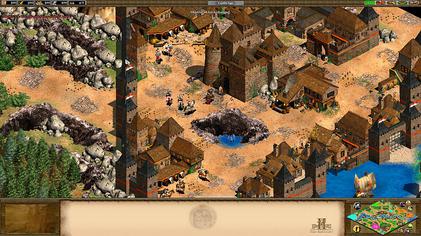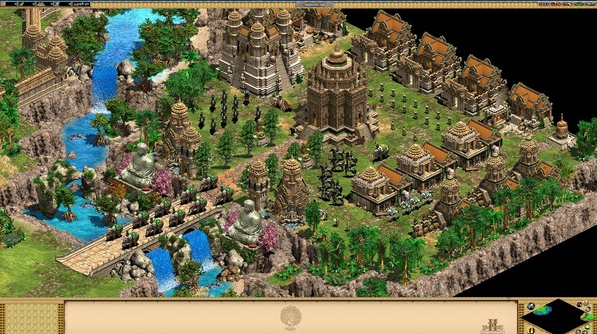
Age of Empires (1997) and The Rise of Rome Expansion (1998) (AoE) allowed you to take part in the rise and domination of ancient civilisations such as the Egyptians, Greeks, Babylonians, Yamato and Romans. The Roman Empire has now collapsed and a power vacuum has appeared in Europe. You can take control of civilisations such as the Mongols, Holy Roman Empire, Moors, and Franks, and follow the stories of some of history’s most famous leaders such as Joan of Arc, William Wallace, El Cid, Saladin, and Barbarossa. It’s time to shine up your armour, sharpen your weapons, and prepare to build an army capable of dominating your enemies. We are now in the Age of Kings!
The Age of Kings
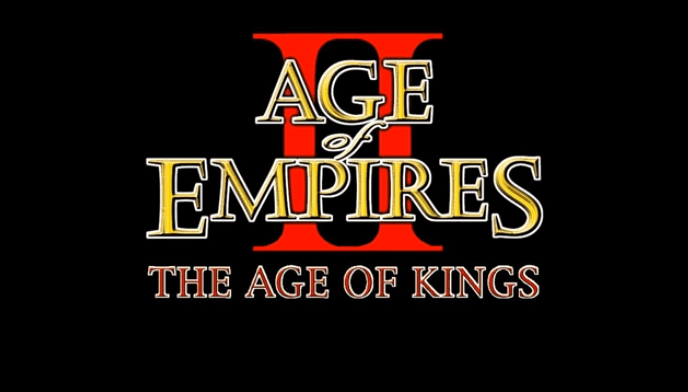
Released in 1999, Age of Empires II: The Age of Kings is a real-time strategy game and the sequel to Age of Empires. It was developed by Ensemble Studios and published by Microsoft (for Windows and Macintosh), and Konami ( for Playstation 2) for the 2001 port. A spin-off was created for the Nintendo DS in 2006. I chose to review the PC version.
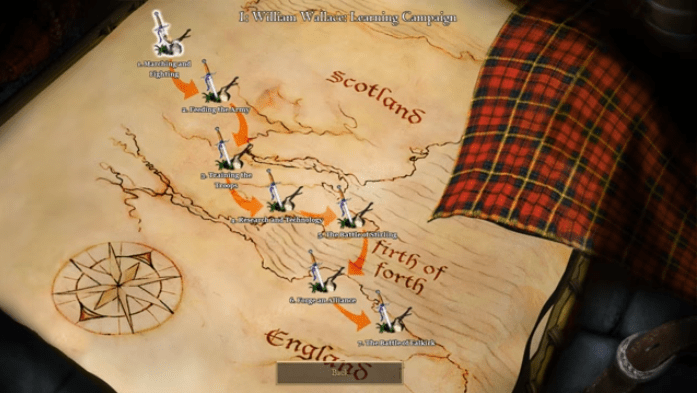
Gameplay
If you are new to AoE, and even if you’re not, a tutorial campaign is available where you help William Wallace (1270-1305) and his armies defend their lands from English encroachment. Other campaigns include:
Joan of Arc (1412-1431): Help the French push the English out of France during the Hundred Years’ War.
Saladin (1137-1193): Fight with the Muslim armies and help expel the Crusaders from the Holy Lands.
Genghis Khan (1162-1227): Lead Khan’s army as they invade Europe.
Frederick Barbarossa (1122-1190): Lead the Teutonic expansion of the Holy Roman Empire.
As with AoE, you have the option to play Campaign or Random Map modes. In Campaign Mode, you are given a specific objective fitting with the storyline. You must send your villagers to collect resources (wood, food, gold and stone) in order to build a base and train an army. By gathering resources you will also be able to progress from the Dark Age through the Feudal and Castle Ages to the Renaissance. If resources are scarce, you can used trade cogs or the market to sell and buy materials.

In Random Map Mode, the computer generates a range of differing landscapes and conditions and you have the option of choosing between 13 civilisations. Once chosen, you can then opt who you compete against, as well as your own aand your opponent’s starting ages. You can win by either defeating your enemy, by building a Wonder that stands for 1000 years, or by collecting relics in a certain amount of time. The additional Deathmatch Mode starts you with an abundance of resources to quickly build a powerful army, and Regicide Mode sees you needing to kill the opponent’s king unit to win.
What’s new?
Before each campaign mission you are greeted with a screen showing text, illustrations, and voice over narrating the context of the mission. During the missions, some of the characters converse with each other offering hints to help find resources, make you aware of enemy locations, or simply helping to move the story along.
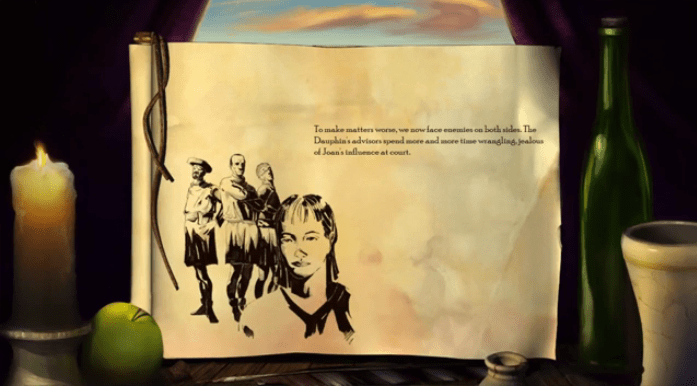
AoE II has also introduced counter-units to ensure more strategic gameplay. For example, infantry such as men-at-arms and swordsmen, are good against buildings but poor against cavalry. So how do you defeat cavalry? You train spearmen and pikemen who, in groups, make short work of cavalry. Each civilisation also has one or two special units. For example, the Britons have Longbowmen, archery units with an increased attack range. Like priests in AoE, monks can convert enemy units and heal your own. They are also able to pick up and carry relics back to their churches. These relics can offer bonuses such as giving you a slow but steady trickle of gold into your coffers.
Another new interesting feature is the option to garrison units in town centres, castles, archery ranges and guard towers. When you garrison archers and villagers into the aforementioned buildings, additional arrows will be fired to help defend your base.
Last, but not least, you are able to read a short history of all civilisations featured in the game. As a history buff I find this a neat little feature as it adds more context to the campaigns and offers further insight into civilisations that we didn’t learn about at school.
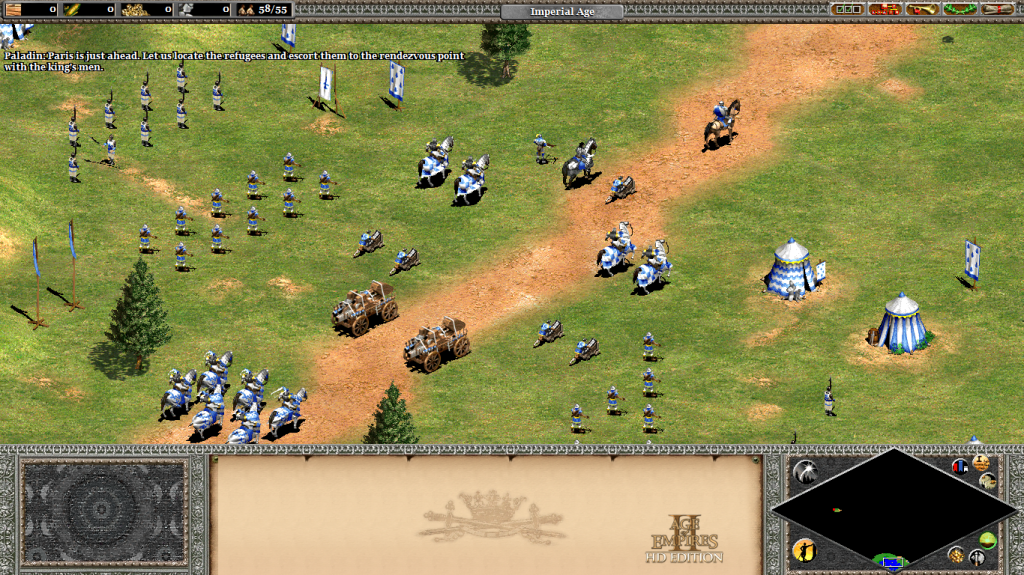
One more helpful feature is the town bell. By pressing the bell icon when the town centre is selected, villagers will automatically garrison in the nearest building, which is handy for when you are being attacked. Interestingly, villagers are now male and female adding more realism to the game.
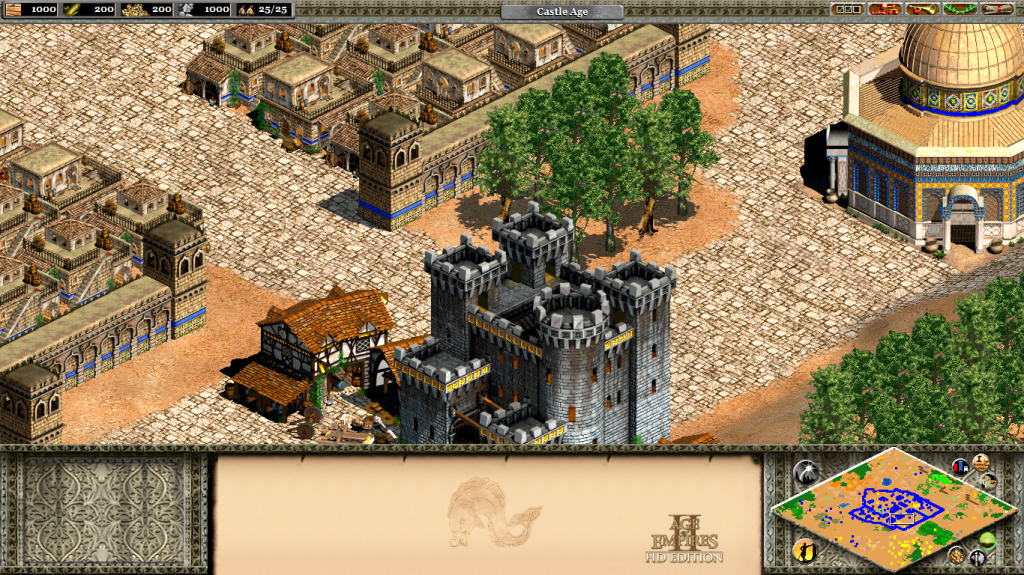
Replay Value
This game has tons of replay value. Once you’re bored with the expansion campaigns and random map modes, you can also play multiplayer online where the game really comes into its own, or so I am told.
What The Critics Said:
PC Zone: “Easy to learn, hard to master…detailed graphics and finely balanced units. Vastly improved single-player game…perhaps too similar to the original game. Overall 90%”[1]
Gamespot: “No matter how you play it, chances are good that you’ll enjoy Age of Kings if not for its careful historical detail then because its context never takes precedence over the game’s playability. And if you’ve ever liked any other real-time strategy game in this classical style, then you’ll clearly see why this one deserves so much credit, even in direct comparison to the finest examples in its category. Overall 9.1/10”[2]
Awards:
1999 Strategy Game of the Year – http://www.Gamespot.com
Best of ’99 Strategy Game – Gamepower
Editor’s Choice – PC Gamer
Editor’s Choice – Computer Gaming World[3]
Wikipedia states that AoE II won several other awards but I have been unable to verify those claims.
The Conquerors

Gameplay
In 2000, the Conquerors Expansion was released adding five new civilisations (Aztecs, Mayans, Spanish, Koreans and Huns) and four new campaigns:
Atilla the Hun (406-453): Follow Attila’s rise to power as he battles against a crumbling Roman Empire.
Montezuma (1466-1520): Ruler of the Tenochtitlán who must defend the Aztec Empire from Hernán Cortéz and the Spanish invasion.
El Cid (1043-1099): The Castillian knight who fought for both Christians and Muslims in Spain.
Battles of the Conquerors: A group of unrelated but famous historical battles including the Battle of Hastings (1066), the Battle of Tours (732), and the Battle of Yamazaki (1582).

The Conquerors introduces several new features and tweaks. New building styles and units indicative of the civilisations have been added such as the Eagle Warrior for the Aztecs. The addition of the King of the Hill, Defend the Wonder and Wonder Race scenarios, add new criteria for winning Random Map games. New winter and tropical maps have been included, and it is now possible to garrison infantry troops inside battering rams, increasing their speed and attack strength.
How Does It Handle?
AI has been improved to help manage your settlement. For example, villagers will automatically begin to collect the nearest resource once they have built a resource gathering site such as the lumber or gold mine sites. When building walls, villagers will spread out and build separate parts of the wall rather than massing on one block at a time. Also if more than one villager is sent to a farm, the second villager will automatically seed a new farm and begin to harvest food. Siege weapons such as mangonels and onagers will not automatically fire if they are at risk of hitting their own soldiers, which I know was something that annoyed a hell of a lot of gamers about AoE and AoE II.
What The Critics Said:
Gamespot: “Virtually every addition in The Conquerors helps make Age of Empires II a better, more thoroughly enjoyable game. Nevertheless, it’s true that the enhancements to the interface and the tweaks to the game’s balance are more obvious to more experienced Age of Kings players. This is largely because Age of Kings was an outstanding game to begin with – and as such, any improvements in an expansion pack such as The Conquerors understandably provide only a marginal improvement overall. At the same time, the multiple additions in The Conquerors add up to be more than enough to entice Age of Kings players to focus their attention on this ambitious, deeply strategic game once again – and for a long time. Overall 8.5/10”[4]
Awards:
According to Wikipedia, The Conquerors won PC Gamer US Best Expansion Pack of 2000, but I was unable to find the magazine to verify.
The Forgotten
In 2013 another expansion pack, The Forgotten, developed by SkyBox Labs and Forgotten Empires, and published by Microsoft Studios, was released.
Gameplay
It introduced five new civilisations: Italians, Indians, Slavs, Magyars, and Incas. It also offered seven new campaigns which included:
Alaric of the Visigoths (370-410): Fighting back against the Romans.
Bari (c.800-Middle Ages): The fall of Rome left room for competing Italian states to try and gain power. Here is the story of one such Byzantine family.
Sforza (15th century): Sforza is a mercenary offering his services around Italy where they are needed. His fate is in your hands.
Dracula (1428-1477): The Story of Vlad the Impaler amidst incursions from the Ottoman Empire.
El Dorado (1540-41): Francisco Orellana and Gonzalo Pizarro travel to South America in search of the Lost City of Gold hidden somewhere in the Amazonian rainforest.
Prithviraja III (reign c.1178-1192): Help Prithviraja III unite the warring clans of India.
Battles of the Forgotten: More independent historical battles including the Conquest of Cyprus (1570-73), Battle of Langshan Jiang (919), and Dos Pilas (629-761).
As well as new technologies and new units consistent with the new civilisations, it also introduced Capture the Relic and Treaty modes for Random Map games. Not only are new maps included but some maps have been expanded so that they are four times bigger than previous maps.
How Does It Handle?
The Forgotten fixed a few bugs noted from the Age of Kings and The Conquerers.
What The Critics Said:
I was unable to find critic reviews for The Forgotten, although it has had mostly positive ratings from users on Steam.[5]
The African Kingdoms
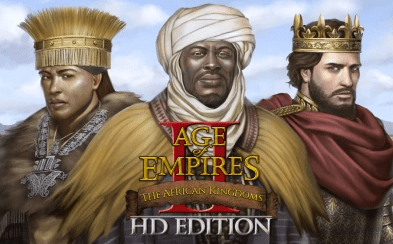
In 2015 yet another expansion pack called The African Kingdoms was released.
Gameplay
It introduced four new civilisations (Berbers, Ethiopians, Malians, and the Portuguese). The new Campaigns included:
Sundjata (Malians c.1217-c.1255): The Ghanaian Empire has fallen leaving a power vacuum in West Africa. Help Sundjata build the Malian Empire and rule over West Africa.
Francisco de Almeida (c.1450-1510): Wars between the Moors and Christians have taken its toll on Portugal. They must branch out to find new sources of wealth unavailable to them in Europe. You must help push East to India.
Yodit (Ethiopans c.960): The Ethiopian Princess is accused of theft by her jealous nephew and is forced to flee her homeland. Help her regain her birth right.
Tariq ibn Ziyad (Berbers invasion of Spain and Portugal 711-718): Lead your army across the Strait of Gibraltar to wealth and glory in Iberia.

As well as the usual bug fixes, tweaks, new units and technologies, consistent with the new civilisations, and new maps; a new mode, Sudden Death mode, was added.
What The critics Said:
I was unable to find critic reviews of The African Kingdom, although it has had very positive ratings from users.[6]
The Rise of the Rajas
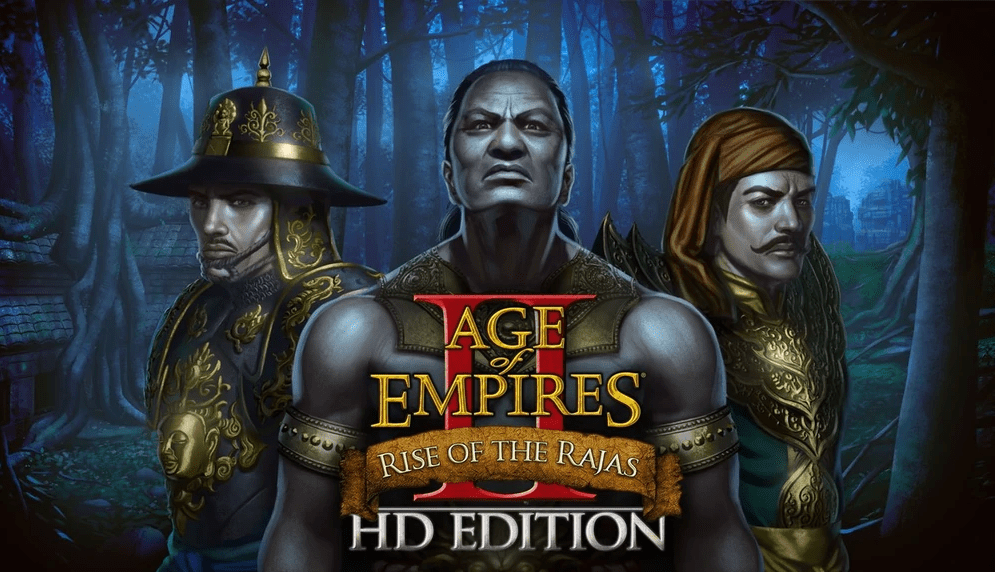
Finally, in 2016, The Rise of the Rajas expansion pack was released.
Gameplay
It included four more civilisations (Burmese, Malay, Khmer and Vietnamese). The new campaigns were:
Bayinnaung (Burma 1516-1581): A warrior king is betrayed and assassinated. His devoted servant pledges to carry on his legacy and seeks to reunite south-east Asia and create an empire.
Suryavarman I (Cambodia 1002-1060): The Khmer Empire is in turmoil due to internal politics and warring factions. There are also external threats from the surrounding, hostile neighbours. You must help Suryavarman I rise to power, defeat the warring factions and restore the Khmer Empire to dominance.
Gajah Mada (Java 1290-1364): Prime Minister of Majapahit, Gajah Mada, plans to build an empire that will rule the archipelago. However, he has sworn an oath to the king. How will he reconcile his ambition and his loyalty?
Lê Lợi (Vietnam 1384-1433): Vietnam is in the midst of a civil war and the Ming Empire of China has intervened and seized control. Minor noble Lê Lợi must reunite the warring factions and regain independence.
As with the other expansions, many bug fixes and balance changes were made. A multitude of more maps were added, as well as the usualy building and unit style changes consistent with their respective civilisations.
What The Critics Said:
I was unable to find critic reviews of Rise of the Rajas, although it has had very positive ratings on from users on Steam.[7]
How Does It Handle?
The game is easy to learn and navigate but difficult to master. Attempting to master it is not for the faint hearted either. All actions are controlled by the mouse but you have the option to use hot keys which allow you to create units whilst you’re off monitoring other aspects of the game.
The campaigns are excellent and are far superior to AoE. Before each misson, the cut scenes really help set up each scenario, drawing the user into the story. The mix of different civilisations and empires rising and falling is based on real history, highlighting how violent our past was, and how things could easily have turned out differently for the winners and losers. Imagine if the Normans were defeated at the Battle of Hastings, or if the Aztecs were able to repel the Spanish invasions. History may have turned out very differently. The addition of the expansion packs focussing on the history of not just European empires, but Asian, African and South American empires as well, means that the history of those non-European empires can be brought to the western world, where these histories are not taught in mainstream education. Learning about other cultures and histories will only enrich us.
One of the downsides to AoE was that once you had an army of maxed out hoplites, you could pretty much win any scenario. The introduction of counter units in AoE II has added an extra challenge to the game, forcing players to use a plethora of different units in their armies in order to be successful.
Graphics
The graphics of AoE II and all respective expansion packs are gorgeous. The lush green maps, arid deserts, and coastal areas are vastly improved from its predecessor. The buildings and units are more colourful and intricately illustrated, adding to the idea that technology has moved a long way since the Classical world. Although not perfect, and there are plenty of similarities, they have done a fine job in trying to create unique buildings and units distinctive to their respective civilisations.
Music and SFX
The music has also been improved. Although the in-game background music isn’t designed to take your attention away from the action, the music adds a feeling of dread to the game, and is very atmospheric.
The narration of the scenarios and the in-game conversations between characters in campaign modes gets a big thumbs up from me. The in-game sounds of the dull of axes hitting tree trunks or the ‘tink, tink’ of pick-axes against stone and gold, or the sound of the sea as your fisherman fish are just a few sounds that really stand out for me. The game has awesome SFX.
Personal Experiences
For me, what lets this game down, and this is why I have only given it four stars instead of five, is that I feel that this was made for hardcore real-time strategy gamers only. There is nothing wrong with that of course. What I mean is that I found the majority of the missions too difficult, even on the easiest difficulty setting. You barely have time to figure out your location before you are inundated with wave upon wave of attacks. In some cases I got the feeling that the game must be cheating as they seemed to have an inexhaustible supply of resources.
“Get good!” I hear some of the hardcore real-time strategists say.
You may be right. Maybe I need to get better, but surely that is why difficulty settings are there. I also found that some of the missions took over two hours to complete. That just seemed too long for me.
Did I Complete The Games?
I have completed the games, but I mostly had to use the resource cheats as even the standard difficulty setting proved too difficult for me on many occasions.
My Verdict:
“All real-time strategists will love this game. The sequel and expansion packs are great value for money with tons of replay value. They are beautifully designed and very challenging. Too many similarities between units of different civilisations and the overall difficulty was too apparent to allow a clean sweep of five stars.”
Rating:

What are your memories of Age of Empires II? I would love to hear your thoughts, and don’t for get to follow and subscribe so that you don’t miss my latest reviews! You can also find me on Instagram: @nicklovestogame.
[1] Shoemaker, R., ‘Reviews – Age of Empires II: Age of Kings’. PC Zone. (Xmas 1999). Issue 84:72-75.
[2] Kasavin, G., (12th October 1999). ‘Age of Empires 2: Age of Kings – Review’. http://www.gamespot.com. (https://www.gamespot.com/reviews/age-of-empires-ii-the-age-of-kings-review/1900-2537995/ Accessed on 8th February 2020).
[3] (27th January 2000). ‘“Age of Empires II: The Age of Kings” Crowned No. 1 on Holiday Sales Charts Around the World’. News.Microsoft.com. (https://news.microsoft.com/2000/01/27/age-of-empires-ii-the-age-of-kings-crowned-no-1-on-holiday-sales-charts-around-the-world/ Accessed on 8th February 2020).
[4] Kasavin, G., (25th August 2000). ‘Age of Empires II: The Conquerors Review’. www.gamspot.com. (https://www.gamespot.com/reviews/age-of-empires-ii-the-conquerors-review/1900-2620147/ Accessed 8th February 2020).
[5] ‘Age of Empires II (2013): The Forgotten’. Steam. (https://store.steampowered.com/app/239550/Age_of_Empires_II_2013_The_Forgotten/ Accessed on 8th February 2020).
[6] ‘Age of Empires II (2013): The African Kingdoms’. Steam. (https://store.steampowered.com/app/355950/Age_of_Empires_II_2013_The_African_Kingdoms/ Accessed on 8th February 2020).
[7] ‘Age of Empires II: The Rise of the Rajas’. Steam. (https://store.steampowered.com/app/488060/Age_of_Empires_II_2013_Rise_of_the_Rajas/ Accessed on 9th February 2020).

